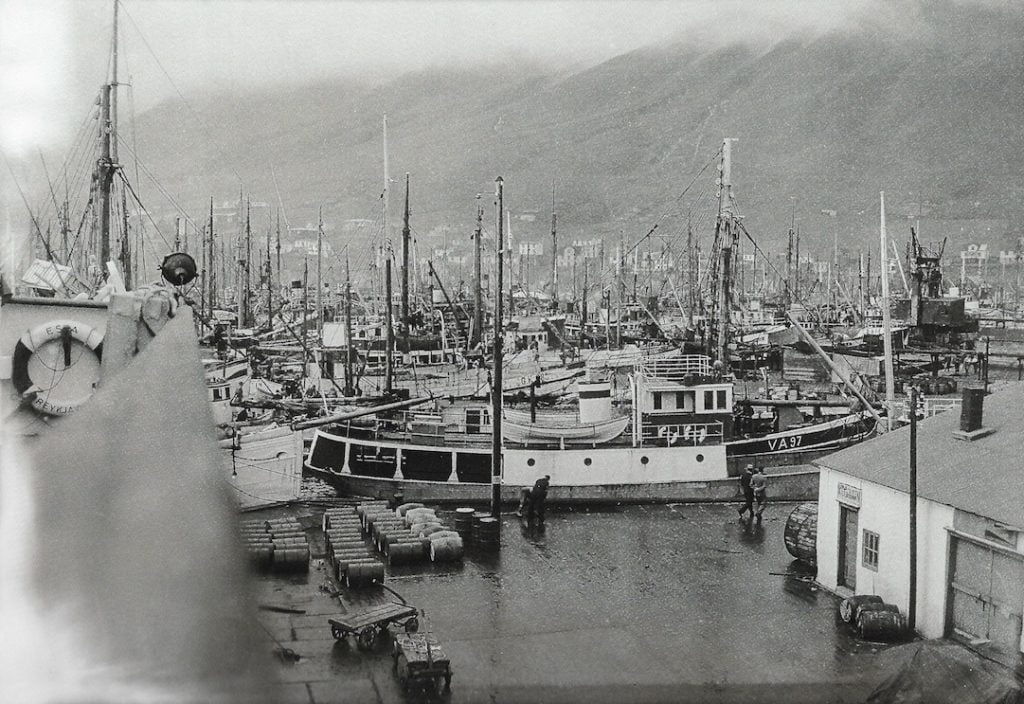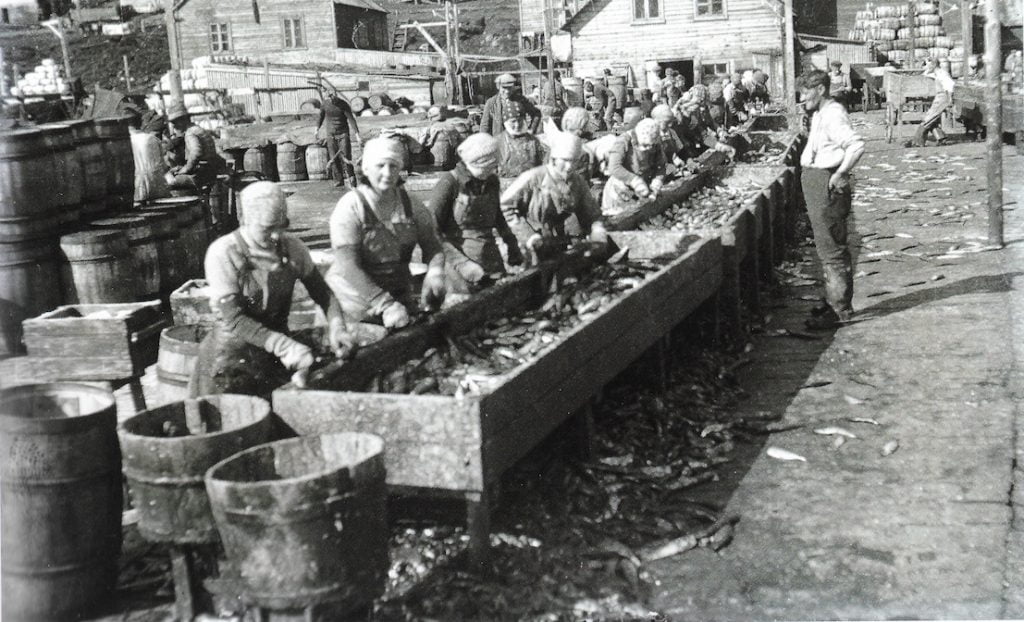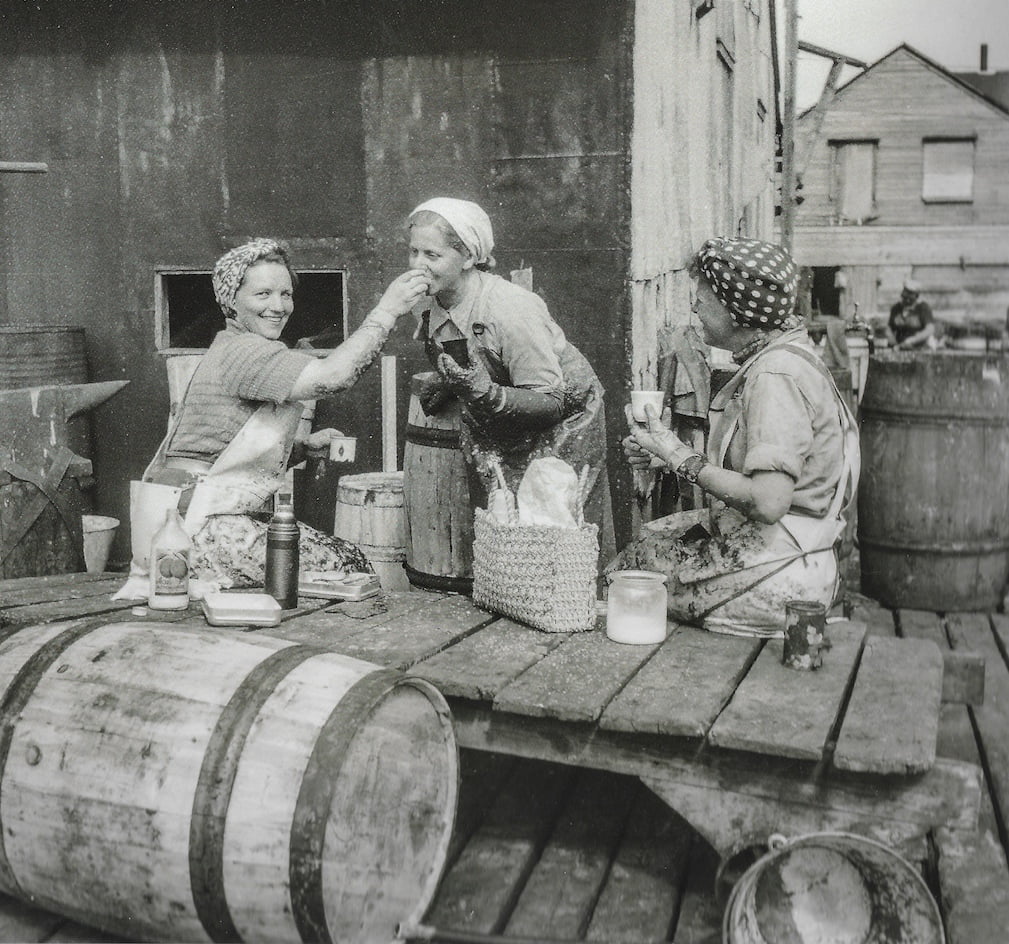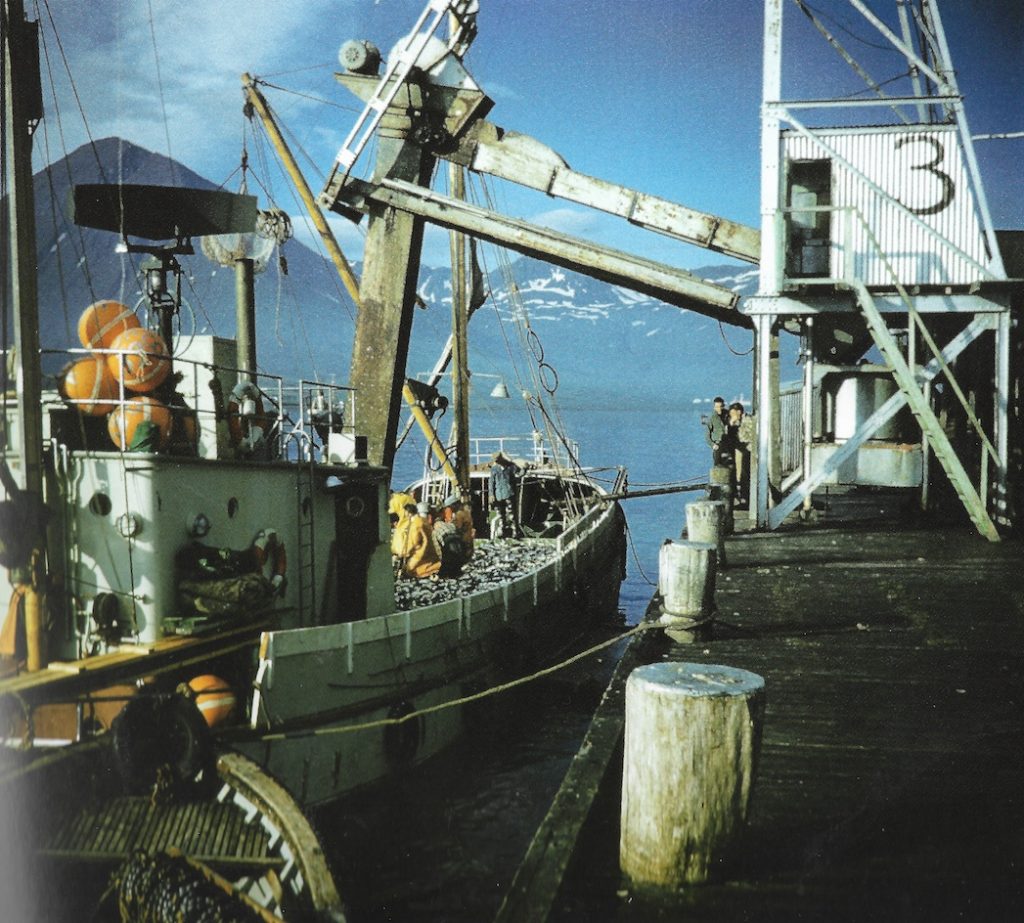A brief history of the brief history of The Herring Adventure, in which our hero transforms an economy and emancipates womankind
ICELANDIC FISHERY
Serious herring fishing came late to Iceland. When it did, Icelanders preferred to export it rather than eat it.
Iceland wasn’t heavily forested even when settlers arrived, but by 1300 trees were already a limited and valuable resource – too limited, too valuable for smoking or heating salt pans. White fish dries well without imported salt.
We don’t know much about what the Gaelic monks ate there, but the C9th Viking settlers who came with Ingólfur Arnarson brought stockfish with them and knew how to prepare it. Either way, no great interest in herring emerged before the second half of the C19th and even then they were just accommodating the Norwegians.
The Herring Adventure
The Norwegians began exploiting herring shoals on the eastern and northern coasts, drawing on their own traditions and working land-based seine nets, which they stretched across the Icelandic fjords. By the early 1880s, a fleet of 187 boats from seven Norwegian towns were mostly purse-seining. There was an investment in coastal property and infrastructure, but pack ice during a series of cold years put an end to things from 1883.
The pack ice receded and the Norwegians returned to test the waters in 1902. They found herring in abundance on the northern coast and the fleets returned the following year.
The potential of Siglufjörður as base for processing and shipping had already been identified – at least in the Norwegian town of Haugasund. Tormod Bakkevig, a herring salter and factory owner, and Henrik D Henriksen, skipper of a herring boat, both arrived from there in 1903 and set about building what was needed.
The Norwegians were probably responsible for bringing the distinctive curing mix to Iceland. Salt, bright red sandalwood and cinnamon, it predominated on the fish quays of northern Iceland. Always imported from Scandinavia, the principle behind the recipe seems to have originated on the Danish island of Bornholm, the spiritual home of buckling. But the infrastructure of the Icelandic fishery was modelled on that of Norway.
Lasting less than 70 years before overfishing brought an end to it, the northern fishery is seen in Iceland as the Herring Adventure. Henriksen’s station, opened in 1904, survived in family ownership through to the end.

The Herring as Emancipator
The Vistarband
To understand the profound impact of the herring fishery in Iceland, it’s necessary to understand the Vistarband, a feudal system that operated with only limited changes from 1490 to 1894.
You could not be a free worker in Iceland without property. The landless had to belong to a farm. Each year, you could sign up to another farm, but you could not leave it without permission.
The farm fed and clothed you, but anything earned working away belonged to the farm, which contracted you out. With no earnings, it was hard to break free from it, particularly for women.
25% of the population were landless.
The Vistarband came to an end less than 10 years before the start of the Herring Adventure. As with slavery elsewhere, the broad economic culture persisted even though the system had been outlawed.
Local merchants met with Bakkevig, Henriksen and the other incoming curers and exporters, offering to provide contract labour, but the Norwegians said, no, they’d pay their workers themselves. This was a popular move.
It was the first time many of Iceland’s landless had had their own money. In the season, they flocked to Siglufjörður and the other herring station towns along the north coast.
Traditionally, the northern fishermen had concentrated on sharks, probably after the manner recreated by the filmmaker Robert Flaherty in Man of Aran (1934). Ready money is a powerful force in cultural change, however. As well as the fishing, jobs on the quayside proliferated: gutting, salting, barrelling and later the work in canning, fish oil and fishmeal factories.
By 1916, Icelandic involvement in the Icelandic herring fishery – both catching and salting – had become greater than that of the Norwegians, but the patterns of labour organisation had been established. It was Iceland’s first major experience of industrialisation and, however sentimental some owners might have felt about the old feudal ways, the economic potential of the herring generated greater enthusiasm.
The Herring Girls

If the Vistarband had been bad for women, the herring fishery was good. Men on the dockside tended to be waged, the sildarstülka or herring girls were on piecework, but if you were good at the job you could gut, salt and pack very quickly indeed. A skilled sildarstülka could out-earn the men, which gave them economic leverage in the home at the season’s end.
Unsurprisingly popular culture responded with stories of moral decline, but these were not enough to undermine a growing sense of unity amongst the women: whereas they had been quite isolated on the farms, throughout the herring season, they worked together in teams for mutual benefit; lived together in company accommodation; socialised together. Before too long they began to organise together.

In 1920 they set up a sildarstülka union. In 1925 they went on strike for 1 krona a barrel. They knew their power – the fish are there for a certain period and you either catch them or you don’t. Once you land them, they have to be processed immediately if you want to fetch anything like a decent price. With herring rotting on the quayside, the owners caved in.
The union was never able to do much about the hours, which were determined by the scale of the catch, but pay and conditions steadily improved. The strike was a pivotal moment. A major shift had been achieved in women’s status and political power – in their sense of it and in that of others.
Catching and Selling
Catching the Herrings
Working away from the fjords, the early Norwegian fleets of the Herring Adventure were drift netters, but catching technologies were already advancing.
The Herring Era Museum at Siglufjörður has early film footage of ring netting, which had been developed in Loch Fyne in the West of Scotland in the 1830s. But the Norwegians were early adopters of purse seining, which had been developed in the USA. This enabled off shore pelagic or mid-water trawling. Within a very few years, the purse seine dominated.
Drift nets are static and rely on the shoals actively swimming into the mesh, the size of which allows the young to swim through. Actively surrounding the shoal, in a trawl net the weight of fish blocks the escape routes. It’s hugely efficient, but this isn’t always a good thing.
The herring grounds on Iceland’s north coast had mixed populations: Icelandic Summer Spawners, Norwegian Spring Spawners and Icelandic Spring Spawners – the Norwegian Spring Spawners migrating to feed there.
Spawned in colder northern waters the herring adapts by growing extra vertebrae. At 25 – 30cm, the adult herrings caught in Iceland are large and fat and popular with buyers, particularly in the hugely significant Russian market.
Selling the Herring
Coming late to herring fishing Iceland benefitted from Norwegian expertise – and that of other nations. Quality was tightly controlled from the start.
Magnus Vagnsson’s instructional Handbók – Sildverkunarmanna may not have brought any radical shift from the curing methodologies developed by the Dutch between the C14th to C16th, but it was not under any circumstances to be shared with the opposition.
The prime quality adult herrings were mostly salted and barrelled for export. Canning factories took these and the juveniles which purse seining also caught. All surpluses or damaged fish could be sold at a lower price to reduction factories, separating oil from fishmeal, which was used for livestock feed and fertilizer.
European herring fisheries suffered badly during both C20th world wars, but Iceland was neutral. The British had dominated both Russian and German markets: Iceland benefitted.
German use of herring oil in the production of high explosives was a bonus.
By and large the British fleet had stuck to drift netting. Between the wars, the efficiency of Icelandic purse seining made its herring competitive in the context of cash-strapped and hard bargaining German and Russian buyers.
Catching Too Many Herrings
Overfishing
Purse seine nets can surround a whole shoal, the market responding by finding value in juveniles, spent herrings and surpluses. It wouldn’t have taken much to recognise the dangers. There were a series of poor catches around 1950, but like other nations, the Icelanders carried on regardless.
The folly was compounded by the Norwegians, who fished the same adult Spring Spawners in their own waters. And the Spring Spawners’ fjord-feeding juveniles, which went to the sardine canneries of Stavanger. And the rest, which went to their own fish reduction plants.
In 1969 the boats set out for the northern Iceland herring grounds, but the herrings did not meet them there.
Collapses and Recoveries
The impact of a simultaneous collapse in the three herring populations involved was profound. At its peak the Herring Adventure had delivered between 40% and 50% of Iceland’s export income, half of that coming from the processing businesses of Siglufjörður, which had become the country’s second-most important town.
The factories and quaysides were abandoned. A way of life came to an end.
Cod populations off the southern coast were showing dangerous signs of collapse. The herring populations of the North Sea, which collapsed a few years later, were already clearly in decline.
Over the C20th fishing had assumed enormous importance in Iceland’s economy. Its response to the crisis was determined. There was a ban on herring fishing, but even more significant was taking control of its fishing grounds.
Iceland had achieved independence from Denmark in 1944. In 1949 it had extended its fishery limits off the northern coast to 4 nautical miles, but the British hadn’t traditionally involved themselves in the herring fishery there, so there was no Herring War.
A general increase to 12 nmi in 1958 led to the First Cod War. In 1972, three years after the collapse of the herring fishery, the limit was extended to 50 nmi (Second Cod War). After three more years it set the fishing limit at 200 nmi (Third Cod War).

The Icelandic Spring spawning herring population has never returned. The other two populations have recovered, but relocated to the East and South Coasts. Strict quotas have been introduced for all the countries participating in the fishery – Iceland itself, Russia, The Faroes, Norway – and there is a partnership with Norway addressing the conservation of the population they share.
So far, the approach has achieved a sustainable fishery, but there are only 10 to 15 vessels involved today, each one with the capacity in a week to catch what 7 boats would once have caught over a whole season.
But Today…
The herring fishing gone in northern Iceland, Siglufjörður is, however, now home to The Herring Era Museum, a splendidly rich and informative exploration of The Adventure. Housed in a set of abandoned herring industry buildings, with a new one built around its beautiful boat collection, it’s well worth the five or six hour drive from Reykjavik.
